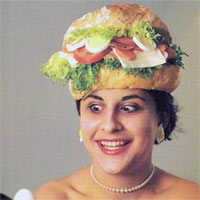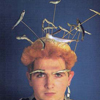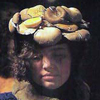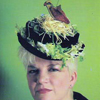Edible Hat Postcards, 1995
 |
The Edible Hats Postcards is a project which stands out from others as it was not created as a performance but as a series of images, photographed by Alejandro Pradera. The idea for the Edible Hats came to Alicia as she was beginning her archive of food and drink related post cards, which to this day she continues adding to. As her collection grew so did her enthusiasm as she began to discover the wide range of subjects depicted and motivations behind the various images. She decided to reciprocate in this economy of images and create some of her own that she could exchange with other archivists, collectors or museums, or even use as business cards. These images were thus conceived to be shared and traded easily. Some of the hats were created with a particular idea in mind while others were inspired through collaborative play with the ingredients, the result of trial and error. In fact, this project marked the beginning of Ali&Cia. It was a collaborative effort that included the participation of Alicia's niece and Ali&Cia co-founder, Bárbara Ortíz, and several of her friends.
While whimsical in appearance, the images assert both the cultural role performed by food and it's prominence in our subconscious. As Alicia asserts:
Although at first glance these hats may seem frivolous, I intend quite the opposite. Just as the goddess Athena was born winged from the head of Zeus, so these edible hats relate to the world of ideas, to the collective subconscious that arises from the head. These hats are, for me, like altars that bear the most sacred and peaceful offerings.
This unusual transformation of an everyday object belongs to the Surrealist tradition and can be related to works such as Dali's Lobster Telephone, 1936 or Meret Oppenheim's Breakfast in Fur, 1936, a fur lined teacup, saucer and spoon. The Japanese artist Michiko Kon also works in this tradition, photographing her elaborate still lifes and objects in which food and clothing are often combined. Cuttlefish and Sneaker, 1989, is an incredible imitation of a Chuck Taylor trainer where the canvas and laces have been crafted from cuttlefish flesh. She has also created several hats out of fish skins and seafood; Yellowtails and Hat, 1986, Oysters and Hat, 1992, Silk Hat and Sardines, 1994.
Like the Surrealists, Alicia draws on the collective subconscious, creating works where our fantasies explode onto the scene of our everyday lives. However, while these other works are regularly sinister and confrontational, incorporating materials whose sensory qualities make them repulsive and frightening, Alicia's creations are not aggressive but whimsical. As she states, these images '...are meant to provoke delight, even as they emphasise the important role of food in our lives.'(1)
Her humorous transformation of the everyday is similar in spirit to Pop Artist Claes Oldenburg's giant vinyl sculptures, often of food or food related objects, such as the large Soft Hamburger, 1962 or his 3.5 m long Floor Cone of the same year. A Pop Art element can also be seen in some of the edible hat images, especially Hat of Galician loaf filled with vegetables, cold cuts and cheese and Perm with carrot rollers. Their bright colours and the suggestion of elegant domestic bliss recall American advertisements of the 1950s.
However, other images in the series are not as colourful or exaggerated as these. Alicia's Delicatessen trousseau and chillies in which a young woman wears a headpiece and necklace of sausages, has various classical allusions in the wreath-like form of the headpiece, the simple white dress, suggestive of a tunic, and the girl's thoughtful, inward gaze.
Mourning headdresses with mushrooms and radishes also establishes a more sombre atmosphere, relating to the still life tradition. The highly selective lighting of the array of mushrooms on the head of the foreground figure, set against a black background, recalls still life painting of the 17th century. That it is a scene of mourning which is depicted relates to the fact that these paintings were often reflections on mortality, a theme perhaps also invoked by the animal skins worn in the picture.
Article by Alicia Rios
Edible Hats (download pdf)
Gastronomica: The Journal of Food and Culture, Winter 2005, 5.1, pp. 113-4.
Extra:

(1) Ríos, Alicia ‘Edible Hats', Gastronomica: The Journal of Food and Culture, Winter 2005, vol. 5, nº 1, pp. 115-6, p. 116.
|




